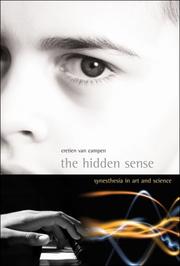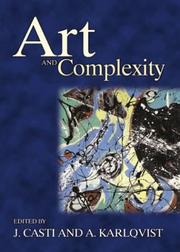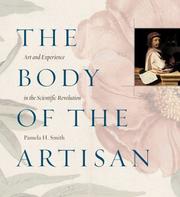| Listing 1 - 10 of 79 | << page >> |
Sort by
|
Book
ISBN: 9789043016070 9043016071 Year: 2008 Publisher: Amsterdam : Pearson Education,
Abstract | Keywords | Export | Availability | Bookmark
 Loading...
Loading...Choose an application
- Reference Manager
- EndNote
- RefWorks (Direct export to RefWorks)
Essays over kunstenaars en wetenschapsbeoefenaars, waarbij wordt aangetoond dat de kunst soms op de wetenschap vooruitloopt.

ISBN: 9780262220811 0262220814 0262265001 0262285401 0262514079 1282100548 9786612100543 Year: 2008 Publisher: Cambridge (Mass.): MIT Press,
Abstract | Keywords | Export | Availability | Bookmark
 Loading...
Loading...Choose an application
- Reference Manager
- EndNote
- RefWorks (Direct export to RefWorks)
Synesthesia. --- departement Beeldende Kunst 10 --- synesthesie --- kunst en wetenschap
Book
ISBN: 9071759164 Year: 1999 Publisher: Utrecht Centrum voor onderzoek Hogeschool voor de kunsten Utrecht
Abstract | Keywords | Export | Availability | Bookmark
 Loading...
Loading...Choose an application
- Reference Manager
- EndNote
- RefWorks (Direct export to RefWorks)
kunst --- kunstonderwijs --- academisering --- onderzoek in de kunsten --- Nederland --- globalisering --- auteursrecht --- kunst en wetenschap --- 373.67
Book
ISBN: 0140551190 Year: 1976 Publisher: Harmondsworth Penguin Books
Abstract | Keywords | Export | Availability | Bookmark
 Loading...
Loading...Choose an application
- Reference Manager
- EndNote
- RefWorks (Direct export to RefWorks)
Kunstgeschiedenis --- Geometry. --- Geometry --- Aesthetics of art --- geometry --- art theory --- kunst en wetenschap

ISBN: 0444509445 9780444509444 9780080527581 0080527582 1281057304 9786611057305 1493302256 Year: 2003 Publisher: Amsterdam Boston : Elsevier,
Abstract | Keywords | Export | Availability | Bookmark
 Loading...
Loading...Choose an application
- Reference Manager
- EndNote
- RefWorks (Direct export to RefWorks)
This title is the result of a one-week workshop sponsored by the Swedish research agency, FRN, on the interface between complexity and art. Among others, it includes discussions on whether ""good"" art is ""complex"" art, how artists see the term ""complex"", and what poets try to convey in word about complex behavior in nature.
Differential geometry. Global analysis --- Science and the arts --- Complexity (Philosophy) in art --- Arts and science --- Arts --- 7.01 --- esthetica --- kunst --- kunst en wetenschap --- kunsttheorie

ISBN: 0226763994 9780226764238 9780226764269 9780226763996 Year: 2004
Abstract | Keywords | Export | Availability | Bookmark
 Loading...
Loading...Choose an application
- Reference Manager
- EndNote
- RefWorks (Direct export to RefWorks)
Since the time of Aristotle, the making of knowledge and the making of objects have generally been considered separate enterprises. Yet during the late sixteenth and early seventeenth centuries, the two became linked through a “new” philosophy known as science. In The Body of the Artisan, Pamela H. Smith demonstrates how much early modern science owed to an unlikely source-artists and artisans. From goldsmiths to locksmiths and from carpenters to painters, artists and artisans were much sought after by the new scientists for their intimate, hands-on knowledge of natural materials and the ability to manipulate them. Drawing on a fascinating array of new evidence from northern Europe including artisans’ objects and their writings, Smith shows how artisans saw all knowledge as rooted in matter and nature. With nearly two hundred images, The Body of the Artisan provides astonishingly vivid examples of this Renaissance synergy among art, craft, and science, and recovers a forgotten episode of the Scientific Revolution-an episode that forever altered the way we see the natural world.
Art --- anno 1600-1699 --- anno 1500-1599 --- Art and science --- History --- Science and art --- Science --- 16th century --- 17th century --- cultuurgeschiedenis --- kunst en wetenschap --- Art et sciences --- Histoire
Book
ISBN: 0674063015 0674068513 9780674068513 9780674063013 9780674062146 0674062140 Year: 2012 Publisher: Cambridge, Mass. Harvard University Press
Abstract | Keywords | Export | Availability | Bookmark
 Loading...
Loading...Choose an application
- Reference Manager
- EndNote
- RefWorks (Direct export to RefWorks)
The world shows up for us-it is present in our thought and perception. But, as Alva Noë contends in his latest exploration of the problem of consciousness, it doesn't show up for free. The world is not simply available; it is achieved rather than given. As with a painting in a gallery, the world has no meaning-no presence to be experienced-apart from our able engagement with it. We must show up, too, and bring along what knowledge and skills we've cultivated. This means that education, skills acquisition, and technology can expand the world's availability to us and transform our consciousness. Although deeply philosophical, Varieties of Presence is nurtured by collaboration with scientists and artists. Cognitive science, dance, and performance art as well as Kant and Wittgenstein inform this literary and personal work of scholarship intended no less for artists and art theorists, psychologists, cognitive scientists, and anthropologists than for philosophers. Noë rejects the traditional representational theory of mind and its companion internalism, dismissing outright the notion that conceptual knowledge is radically distinct from other forms of practical ability or know-how. For him, perceptual presence and thought presence are species of the same genus. Both are varieties of exploration through which we achieve contact with the world. Forceful reflections on the nature of understanding, as well as substantial examination of the perceptual experience of pictures and what they depict or model are included in this far-ranging discussion.
Experience. --- Philosophy, Modern. --- Modern philosophy --- Knowledge, Theory of --- Philosophy --- Psychology --- Reality --- Pragmatism --- Experience --- 7.01 --- filosofie --- kennisleer --- kunst en wetenschap --- kunsttheorie --- perceptie --- waarneming --- Developmental psychology --- Aesthetics
Book
ISBN: 9068340484 Year: 1989 Publisher: Bloemendaal Aramith Uitgevers
Abstract | Keywords | Export | Availability | Bookmark
 Loading...
Loading...Choose an application
- Reference Manager
- EndNote
- RefWorks (Direct export to RefWorks)
Anamorphic art. --- Anamorphosis (Visual perception). --- perspective [technique] --- Art --- anamorphoses --- Iconography --- Anamorphic art --- Anamorphosis (Visual perception) --- #gsdbA --- 7.017 --- Gezichtsbedrog --- Kunst en illusie --- Kunst en wetenschap ; optische misleidingen --- Kunst ; optische effecten ; anamorfosen --- Perspectief ; perspectiefkasten ; centraalperspectief --- Optical illusions --- Perspective --- Visual perception --- Composition (Art) --- Kunst ; optische effecten, perspectief, illusie --- Anamorfosen --- Anamorfose --- kunst en wetenschap
Book
ISBN: 0442245327 9780442245320 Year: 1974 Publisher: New York: Reinhold,
Abstract | Keywords | Export | Availability | Bookmark
 Loading...
Loading...Choose an application
- Reference Manager
- EndNote
- RefWorks (Direct export to RefWorks)
Art --- art [fine art] --- Science and the arts --- Technology and the arts --- Arts and technology --- Arts --- Arts and science --- Science and the arts. --- Technology and the arts. --- art [discipline] --- kunst en technologie --- kunst en wetenschap
Book
ISBN: 9026616333 Year: 1977 Publisher: Nijkerk Callenbach
Abstract | Keywords | Export | Availability | Bookmark
 Loading...
Loading...Choose an application
- Reference Manager
- EndNote
- RefWorks (Direct export to RefWorks)
Philosophy and psychology of culture --- #gsdbA --- Francis A. Schaeffer --- kunst --- kunstgeschiedenis --- literatuur --- geschiedenis --- cultuurgeschiedenis --- cultuurfilosofie --- wetenschap --- kunst en wetenschap --- oudheid --- middeleeuwen --- renaissance --- barok --- reformatie --- verlichting --- filosofie --- muziek --- film --- sociologie --- politiek --- 7.03 --- 130.2 --- 930
| Listing 1 - 10 of 79 | << page >> |
Sort by
|

 Search
Search Feedback
Feedback About UniCat
About UniCat  Help
Help News
News